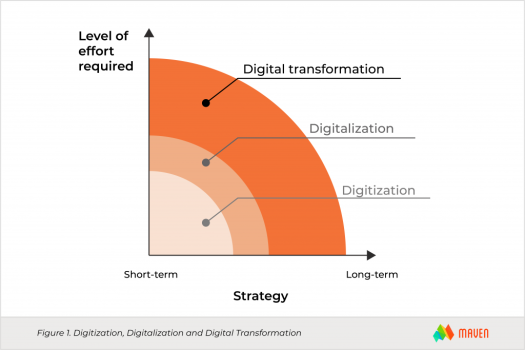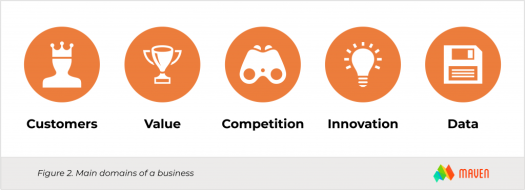It is more difficult than ever to separate the wheat from the chaff when it comes to digital transformation (DT or DX). A simple Google search of the term reveals millions of results of varying levels of quality. The amount of information out there is significant, but only a small portion of that is valuable. It is not unexpected since digital transformations are so complex and multifaceted.
Ultimately, DT will affect every business sooner or later. The question is how you will address digital transformation at your business, and who will be the first, you or your competitor. To help you better understand DT, we have taken our experience as well as some in-depth industry research and combined it into a detailed review of the topic. So let’s dive in!
What is Digital Transformation?
The Difference Between Digital Transformation and Digitalization
Most associate digital transformation with the process of implementing digital technologies into business processes. Right? Not exactly. It’s much broader than that. First, let’s take a look at the differences between digitization, digitalization and digital transformation.

Digitization
The process of digitization is all about converting information from analog to digital. For those of us old enough to remember, business used to be conducted with typewriters and multi-part forms, eventually evolving to word processing and Microsoft Word. Now, important documents could be printed, signed, scanned and saved on a hard drive.
Generally, digitization offers direct cost savings in the short term. In our example above, you no longer waste paper and space on physical document storage, you store it on a hard drive. Without digitization, business growth becomes difficult and costly, requiring additional resources or infrastructure. It is the foundation for any significant digital changes.
Digitalization
Digitalization refers to changes in business processes tied to technology advancements. The business starts to apply digital technologies to change, streamline a workflow. For example, sharing a Microsoft Word document with your colleague using OneDrive, editing the document together, and sending it to the boss by email is a simple digitalization example.
While it seems easy, It can be challenging to implement digitalization. Implementation requires a certain level of technical competency as well as flexibility in business structure. The benefits are tangible. Increasing the level of automation can cut costs, skyrocket efficiency and increase overall productivity.
While it is relevantly easy to go from digitization to digitalization, the journey to digital transformation is far more complex. Why? Because it requires cultural change.
How to understand Digital Transformation?
Digital Transformation is the process of connected changes in a business. An example is the skills required to transition from a propeller plane pilot to a jet plane.

Let’s assume that your business is a propeller plane and you are a pilot of this aircraft. If you want to fly higher (grow faster) and reach new territory (expand), it is not enough to add another tool in the cabin of a propeller plane.
You can add a GPS, or more advanced electronics to a propeller plane (Digitizing), or some additional systems to perhaps make flying more efficient (Digitalizing), but the plane won’t go any faster or higher than it was designed. To achieve the next level, your business needs a jet plane (Digital transformation).
But the jet has dramatically different technologies (tools, systems), different processes, and different methods of interaction and responsibilities for the flight crew. Management (pilot) of the jet must commit to a different approach than was used for flying the propeller plane. Digital transformation starts with a commitment to change by Management.
The Real Nature of DT
The competitive nature of business drives companies that want to succeed and thrive to implement innovations. The best innovations can attract customers and create a competitive advantage.
Unfortunately, businesses quickly evolve and innovations lose their competitive edge as other companies copy them. Only a company with a culture of innovation can continuously improve, inventing and implementing new solutions.
Innovation and transformation must be at the core of the company’s vision and strategy. From the C-suite down, the organization should promote and encourage an innovative spirit and empower individuals and departments to regularly evaluate all aspects of the business. Leveraging technology and open communications create winning business strategies.
The Definition of Digital Transformation
Digitalization is an important component of DT, but only part of it. DT includes strategies to create a sustainable competitive advantage. It is about creating a culture of innovation. The Enterprisers Project made it clear:
Why Should You Care about DT?
Let’s be honest, there is no way to escape the digital world. We used to think that technologies develop quickly, but not at a rate that would immediately impact our business. COVID 19 and the subsequent shift to remote, online work impacted users’ interaction with the digital world almost instantly. Your business must adapt and transform to keep pace. Digitalization is just a starting point.
Unfortunately, digitalization can not help you find new ways to deliver value, change customer experiences or switch business models. Digitalization, as we discussed above, only impacts routine processes.
The long-term strategy should include adaptability and scalability. That where DT comes in. It changes the strategy across every aspect of the business and helps to stay relevant over the long-term.
Read also: Silent Business Killer: 5 Signs that You are Facing Legacy Software and How to Deal With It
You cannot influence digital technologies, and, no matter your opinion, DT is happening. The question is will you proactively implement it as a strategy or reactively as a rescue necessity when the time comes?
The Approach to Digital Transformation
It can be challenging to define a one-size-fits-all approach to digital transformation that fits every business. As an example, let’s review the framework given by David Rogers, author of “Digital Transformation Playbook”. He suggests rethinking assumptions across five broad domains of business:

- Customers. Market competition is so fierce that mass-marketing approaches no longer work. Think deeply about customer pain points and behavior. Look to innovate your approach to sales and marketing with an eye towards personalization.
- Value. Value is a dynamic variable. Continuous adaptation of it based on the needs of the market is a necessity.
- Competition. Competition today could look differently tomorrow. To win, rethink your business model. Try to look beyond your current state and find ways for your business to become a platform that solves the same problem but more efficiently or for a broader audience.
- Innovation. As we defined earlier, digital transformation is not possible without a culture of innovation. Rethink your innovation approach. Use the power of technology to experiment and analyze. That will help you to create a continuous process of improvement.
- Data. Data is a source of value creation. By using and growing this powerful strategic asset, your business will uncover and create future opportunities.
The Current State of DT
The complexity of digital transformation makes it difficult to rely on any statistics. But it is important to identify two main points:
First, In 2018 Tech Pro research showed that 70% of companies either have a digital transformation strategy or planning to create one. In the same year, IDG reported that 89% of organizations have plans to adopt a digital-first business strategy. However, only 44% have fully adopted this approach.
Most of your competitors are aware of DT and attempting to implement it. While you may not be the first driving a digital transformation, be the first who will do it right.
Second, in 2017 McKinsey shared an interesting finding. The success of digital transformation attempts is around 30%. In most cases, the transformation fails due to resistance from employees.Some of the struggles that companies face being successful include staff that is not ready for innovation, or management who are unable to create a culture of innovation.
Change can be a challenge, and there will be employees who resist digital transformation. You should be prepared for it and develop strategies to handle objections.
To Sum Things Up
Digital Transformation is an ongoing process. Your business should never stop innovating. The goal of digital transformation is to always stay relevant even in the face of changing markets, economics and customer behavior. It is about flexibility, adaptability and scalability. Don’t be afraid to transform your business. Start today by contacting Maven Ecommerce. We know how to help you successfully navigate digital transformation.
wonderful information. this is helpful to me. thanks to you
It is a pleasure to be helpul. Thank you!
Your article is extremely helpful and thank you for that!
Unfortunately, many companies still underestimate the importance of digital transformation for their businesses and simply ignore it.
Thank you! Always happy to share valuable info!
Good article!
Digital innovation is the process of updating your business practices with new technologies and methodologies. Far more than a fad, digital innovation is an essential strategy.
Thank you Tony!
I completely agree with you: being afraid is not about business at all! If a business is not flexible and does not react to external changes, sooner or later it will hopelessly lag behind competitors!
True! Flexibility should be the #1 priority of any business in the modern world.
Great read!
Thanks Hannah!
Great Post!
Thank you, Rinal!